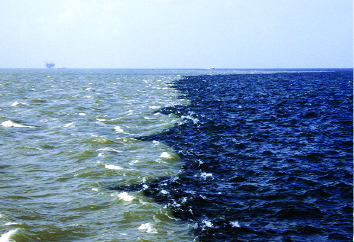Twenty-five years of NCCOS sponsored research shows that the offshore summer hypoxic (low-oxygen) ‘dead zone’ in the Gulf of Mexico is strongly linked to nutrient loading from the Mississippi River. Physical forces (i.e., wind, waves, currents, temperature) play an equally strong role asbiological variables (i.e., phytoplankton growth/decay, photosynthesis/respiration) in creating and maintaining Louisiana shelf hypoxia fed by Mississippi River nutrients. Recent research reveals that nearshore areas are possibly a key to fueling offshore hypoxia, more than previously thought.

The NCCOS sponsored project, led by Louisiana State University and Louisiana Universities Marine Consortium (LUMCON), integrates modeling, observations, and experiments. The study hypothesizes that a band of nearshore waters creates the most productivity in this shelf ecosystem and that particles of organic carbon or ‘POC’ (i.e., living cells and cell parts) move offshore across the bottom of the continental shelf helping fuel the mid-shelf dead zone.
This 5-year study yields three key findings: (1) carbon dynamics link closely to Mississippi River nutrient inputs; (2) net carbon production predominantly occurs nearshore at low salnities; and (3) POC concentration gradients agree with POC transporting offshore across the continental shelf from net autotrophic (photosynthesis)-dominated nearshore areas to mid-shelf heterotrophic (respiration)-dominated regions, fueling summer hypoxia.
The study changes the focus on the origins of the dead zone from extended offshore river plumes to the nearshore regions and to a transport mechanism where subsurface currents transport POC from nearshore low salinity zones to offshore continental shelf zones. Scientists need to understand details of the transport and trapping processes, but these processes are gaining increasing scientific attention. These two shifts in understanding should be considered preliminary as there is not yet decadal-length research solidly supporting these ideas. Future testing of the possible cross-shelf fueling of hypoxia could be worthwhile for management agencies to understand, mitigate, and reduce the Gulf of Mexico dead zone. The study is published in the journal Estuaries and Coasts.
For more information, contact David.Scheurer@noaa.gov.
